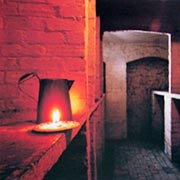A potted history of the basement Kitchen.
There have been frequent references in this column to the on-going work in the kitchen of the Town House. There's been a lot of excitement and satisfaction in each move forward: - a wall completely plastered, the skylight being fixed, the start of the installation of electricity, the clearing out of pigeon detritus and putting up of new laths.
Perhaps a potted history of the kichen itself might explain the excitement of seeing it come to life.
13 Brunswick Square was first purchased from plan in 1828. The period written about in the ‘Character Blogs’ on our website is the 1830’s, as the house was a private family house during the whole of the Regency period.
Things were changing rapidly during this period: steam engines, gas lighting, more sophisticated plumbing and new techniques were rapidly being adopted. Inventions of a kind scarcely imagined fifty years before were now in everyday use.
The houses in Brunswick Square were built to take advantage of all of the above. The kitchens were the spaces in which modernity reigned. Kitchens – especially in the more compact, urban homes – were planned carefully to produce the best results. The world had moved on from food prepared for the purpose of sustenance to the world of haute cuisine. Food was an integral part of social life and, now, of social advancement. The most innovative cooking ranges were installed; plumbing provided hot water as well as cold; the designs and lay-outs of kitchen spaces were carefully thought out to take advantage of light; to combat smells; to regulate temperature and heat, and to maximise efficiency.
The cooks and kitchen helpers in Regency Square were part of this trend and would have felt themselves privileged to work in such ultra-modern conditions.
The Regency Town House remained a single family home – though it did not stay in the same family – until the '50s.
However, the last two owners of the house were both medical doctors. By the early 20th century, and with the employment of large groups of servants no longer possible, the kitchen must have started to seem unnecessarily large.
There would have been no need for either such a large kitchen, nor for the servants' hall by the 20s. This may have been when some of the basement rooms became small surgeries and waiting rooms for the treatment of patients. The kitchen, with its airy skylight and plumbing, became part of the doctors' laboratory. It may even have been used, in part, to perform some kinds of medical procedures. It is also believed that recovering patients were housed in the Town House as in a small kind of cottage hospital. The stables, which were still part of the property, housed a private ambulance. Though no records have yet been uncovered to verify it, it is quite possible that during both world wars, injured troops were taken in on a small scale.
Then, in the 50s the house became one of the last properties in the square to be converted into flats. The stables and outbuildings were separated from the main house and became separate dwellings with different addresses. The interiors were partitioned off, wall-paper hung, modifications made and the fine old house became almost unrecognisable as a multiple dwelling.
So to those working down in the basement, each new discovery of unsuspecting yet original features carries all the excitement of participation in an archaeological dig.
The excitement is twofold. First comes that of discovering, for example, a pattern in the bricks which makes clear that what was always thought of as an original wall is actually part of a bricked-in arch. Then comes the work of using old techniques and materials to restore old features – messy, dirty and often physically demanding work.
So it is a wonderful feeling to look around oneself as work progresses to the stage we have now reached, and to realise that one is not working in a building site, but in a grandly proportioned Regency kitchen. A kitchen which, one can now envisage, will soon be as close to the original as it is possible to get in the absence of photographic evidence.
Personally, I have the answer now, if anyone asks why on earth we bother devoting so much time and energy to an old building. I shall just take them down to the basement kitchen. To see that the real heart of the house still beats.




Add new comment